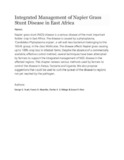| dc.contributor.author | Asudi, George O. | |
| dc.contributor.author | Muyekho, Francis N. | |
| dc.contributor.author | Midega, Charles A. O. | |
| dc.contributor.author | Khan, Zeyaur R. | |
| dc.date.accessioned | 2022-07-13T05:15:33Z | |
| dc.date.available | 2022-07-13T05:15:33Z | |
| dc.date.issued | 2020-02-06 | |
| dc.identifier.uri | https://doi.org/10.1007/978-3-030-29650-6_5 | |
| dc.identifier.uri | https://link.springer.com/chapter/10.1007/978-3-030-29650-6_5 | |
| dc.identifier.uri | http://ir-library.mmust.ac.ke:8080/xmlui/handle/123456789/2055 | |
| dc.description.abstract | Napier grass stunt (NGS) disease is a serious disease of the most important fodder crop in East Africa. The disease is caused by a phytoplasma, ‘Candidatus Phytoplasma oryzae’, a cell wall-less bacterium belonging to the 16SrXI group, in the class Mollicutes. The disease affects Napier grass causing up to 100% crop loss in infested farms. Despite the absence of a commercially available, effective control method, several techniques have been attempted by farmers to support the integrated management of NGS disease in the affected regions. This chapter reviews various methods used by farmers to control the disease in Kenya, Tanzania and Uganda. We also propose suggestions that could be used to curb the spread of the disease to regions not yet reached by the pathogen. | en_US |
| dc.language.iso | en | en_US |
| dc.publisher | Sustainability in Plant and Crop Protection | en_US |
| dc.subject | Integrated, Management, Napier, Grass, Stunt Disease | en_US |
| dc.title | Integrated Management of Napier Grass Stunt Disease in East Africa | en_US |
| dc.type | Article | en_US |

